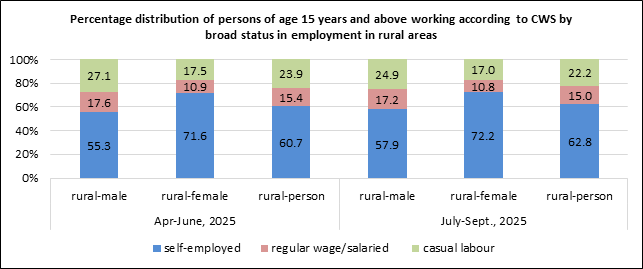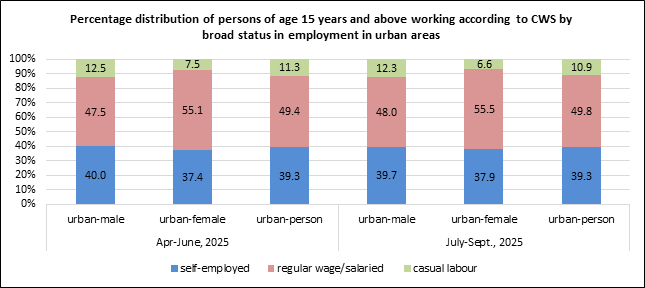Ministry of Statistics & Programme Implementation
PERIODIC LABOUR FORCE SURVEY (PLFS) Quarterly Bulletin July – September, 2025
Female LFPR showed upward momentum
Decline in Unemployment Rates
Urban Tertiary Sector and Regular Wage/ Salaried Employment Grew Modestly
Posted On:
10 NOV 2025 4:00PM by PIB Delhi
|
Snapshot:
- The overall Labour Force Participation Rate (LFPR) marginally increased to 55.1% during July-September, 2025, compared to 55.0% in the previous quarter for persons of age 15 years and above.
- Female participation in the labour force witnessed an increase to 33.7% in July–September, 2025 from 33.4% in April–June, 2025.
- The Worker Population Ratio (WPR) for persons aged 15 years and above exhibited a marginal increase from 52.0% in April–June, 2025 to 52.2% in July–September, 2025.
- The female WPR recorded an increase across all sectors - rural, urban, and overall - during July–September, 2025 compared to April–June, 2025.
- The Unemployment Rate (UR) among persons of age 15 years and above declined to 5.2% in July-September, 2025 from 5.4% in the previous quarter.
- The increase in the share of rural employment in the agriculture sector from 53.5% to 57.7% during July–September 2025 can be attributed to Kharif agricultural operations.
- The share of workers engaged in the urban tertiary sector increased marginally to 62.0% during July–September 2025 from 61.7% in the previous quarter.
- Self-employed workers in rural areas witnessed a notable rise to 62.8% during July-September, 2025 from 60.7% in April-June, 2025.
- Urban areas recorded a modest improvement for regular wage/salaried employees to 49.8% during July–September 2025 from 49.4% in the previous quarter.
|
A. Introduction
The Periodic Labour Force Survey (PLFS) conducted by NSO, MoSPI, is the primary source of data on activity participation and employment-unemployment conditions of the population. The PLFS survey methodology has been modified from January 2025 to provide monthly and quarterly estimates of labour force indicators for both rural and urban India under the CWS framework for the country.
Considering the need to generate high-frequency labour force indicators with wider coverage, the sampling methodology of the Periodic Labour Force Survey (PLFS) was revamped from January 2025. The redesigned PLFS aims to achieve the following objectives:
- To generate key employment and unemployment indicators – namely Labour Force Participation Rate (LFPR), Worker Population Ratio (WPR) and Unemployment Rate (UR) – every month for both rural and urban areas at the all-India level under the Current Weekly Status (CWS).
- To extend the Quarterly PLFS results to rural areas, thereby producing quarterly estimates of labour market indicators for both rural and urban India under the CWS framework.
- To provide annual estimates of key employment and unemployment indicators in both Usual Status (ps+ss) and Current Weekly Status (CWS) for rural as well as urban areas.
Earlier PLFS Quarterly Bulletins, released up to December 2024, presented labour market indicators only for urban areas. The Bulletin for April – June 2025 marked the first in the series to provide estimates for both rural and urban areas and the current Bulletin for July – September 2025 is the second in the series. In this Quarterly Bulletin, efforts have been made to provide estimates of the number of workers in absolute terms.
This Quarterly Bulletin presents estimates of key labour force indicators—Labour Force Participation Rate (LFPR), Worker Population Ratio (WPR), Unemployment Rate (UR), and the distribution of workers by broad employment status and industry of work—in the Current Weekly Status (CWS), separately for rural and urban areas at the all-India level. In addition, state-level estimates of LFPR, WPR, and UR in CWS are also provided for selected States.
Key findings for persons of age 15 years and above following CWS:
- Labour Force Participation Rate (LFPR) marginally improved: The overall LFPR among persons of age 15 years and above held steady at 55.1% during July-September 2025, compared to 55.0% in the previous quarter. A slight uptick was observed in both rural and urban areas — the rural LFPR inched up from 57.1% to 57.2%, while the urban LFPR also registered a modest rise over the same period from 50.6% to 50.7%.
Overall LFPR posted a modest gain, reaching 55.1% in July–September 2025.
|
- Participation of female in labour force continued to rise: The overall LFPR among female of age 15 years and above increased to 33.7% in July-September, 2025 from 33.4% in the previous quarter, reflecting a continued but modest upward movement in women’s engagement with the labour market. This improvement was driven largely by the increase in female LFPR in rural areas from 37.0% in the quarter April - June 2025 to 37.5% in July - September 2025.
Female LFPR showed upward momentum, moving up from 33.4% in April–June 2025 to 33.7% in July–September 2025.
|
- Rise in workforce driven by increased female participation: The overall Worker Population Ratio (WPR) rose marginally to 52.2% in July–September 2025 as compared to 52.0% in April–June 2025. This increase was largely driven by the increased participation of women, particularly in rural areas. The overall WPR for females aged 15 years and above continued to improve during the quarter, reflecting a positive shift in women’s engagement in the workforce.
|
The overall female WPR rose to 32.0% in July–September 2025, up from 31.6% in the previous quarter.
|
- Divergent trend in Unemployment Rate (UR) across rural and urban areas: The UR among persons aged 15 years and above in rural areas declined to 4.4% in July–September 2025 from 4.8% in the previous quarter, driven by reductions among both rural male and female.
In contrast, urban UR edged up slightly, with rates increasing from 6.1% to 6.2% for male and from 8.9% to 9.0% for female during the same period.
- Overall Unemployment Rate (UR) declines: The UR among persons aged 15 years and above dropped to 5.2% in July–September, 2025 from 5.4% in the previous quarter.
|
- Self-employment dominated in rural areas while regular wage/salaried employment in urban areas: Self-employed persons of age 15 years and above in rural areas increased to 62.8% during July- September, 2025, up from 60.7% recorded in the previous quarter April-June, 2025. In urban areas, the share of regular wage/ salaried employment also showed marginal improvement, rising to 49.8% in July-September, 2025 from 49.4% in April-June, 2025.


- Rural workforce concentrated in agriculture sector, urban in tertiary sector: Rural areas continued to show a similar pattern, with the majority of workers engaged in the agriculture sector, accounting for 57.7% during July-September, 2025, up from 53.5% in the previous quarter. This increase in the share of rural employment in the agriculture sector can be attributed to seasonal agricultural operations. In the urban areas, the tertiary sector remained dominant, engaging 62.0% of workers during July-September, 2025, slightly higher than 61.7% in April-June, 2025.


Using the projected population figures of the Ministry of Health and Family Welfare (MoHFW), the absolute number of workers aged 15 years and above has been estimated. On average, 56.2 crore persons (aged 15 years and above) were employed in the country during the quarter of July–September 2025, of which 39.6 crore were male and 16.6 crore were female.
|
At the all-India level, the quarterly estimates are based on information collected from a total of 5,64,828 persons surveyed.
|
|
persons surveyed in rural areas
3,22,992
|
persons surveyed in urban areas
2,41,836
|
|
The Quarterly Bulletin for the quarter July - September 2025 is available on the website of the Ministry (https://www.mospi.gov.in).
|
Scan the below QR code to access the Publications/ Reports

|
Click here to see PDF
***
Samrat/Allen
(Release ID: 2188343)
Visitor Counter : 2016